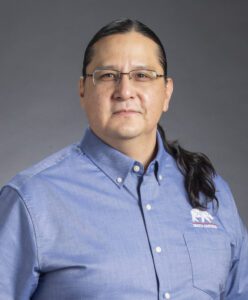Modern gold rush threatens Black Hills
Modern gold rush threatens Black Hills
By Talli Nauman
Native Sun News Today Correspondent
Joseph Robertson (courtesy photo)
RAPID CITY — The results of a recent mapping project by Mato Ohitika Analytics LLC highlight “the vast extent of potential mining projects, as well as the modern gold rush that threatens Black Hills water, health, wildlife, and our recreation and tourism economy,” the Black Hills Clean Water Alliance said at a news conference here Feb. 2.
The founder of Sioux Falls-based Mato Ohitika Analytics LLC, Joseph Robertson, who is an enrolled member of the Sisseton Wahpeton Oyate of the Lake Traverse Reservation, worked with Black Hills surveyor Frank DiCesare to create a set of mining claims maps for the grassroots organization to share with tribes and the public.
With this mapping exercise, Black Hills Clean Water Alliance has identified thousands of active mining claims on federal lands in the tribally unceded Black Hills area, which the U.S. Supreme Court has determined belongs to the Great Sioux Nation.
Robertson, a PhD in Computational Science and Statistics, undertook the work as part of his focus on what his speaker’s bio defines as “developing an ethical, cultural, and Native community-based approach to tribal nation building that incorporates data science to support decision making in education, health care, economic development, resource management, and other areas of tribal governance.”
As chief data scientist at Mato Ohitika Analytics LLC, his role in “strategic mapping” for Black Hills Clean Water Alliance helped conclude that about 148,000 acres in the Black Hills are under either active or filed mining claims. The active claims cover a total of about 230 square miles. Most of them are held by gold companies.
Each claim a mining company has on federal land gives that company the right to mine without paying federal royalties. This is due to the obsolete 1872 General Mining Law. Surface landowners do not have the right to stop mining of sub-surface federal minerals under this law, which was tailored to the needs of a newly industrializing nation. Mining companies operating under this law have uprooted entire towns.
Nationwide attempts to update the law to require federal royalties or to give surface owners a say in the mining process have failed so far. Locally, tribally proposed legislation to prohibit Black Hills mining has fared no better.
“Gold mining and processing are destructive and dirty businesses,” the Clean Water Alliance says. The industry has resulted in two Superfund sites in the northern Black Hills – one including 18 miles of Whitewood Creek downstream from the Homestake Mine in Lead and one at the Gilt Edge Mine on the next mountainside over, just to the south of Deadwood. Modern mining uses cyanide and other toxic chemicals; arsenic is a common byproduct. Studies show the contamination from gold mining in the northern Black Hills reaches to the Missouri River – about 175 miles away.
One of six separate gold companies the organization pinpointed in the northern Black Hills, Dakota Territory Resources (soon to be Dakota Gold Corp.) has more than 35,000 acres of claims. With many more left to map in the Maitland area between Spearfish and Central City, this company has ties to Barrick Gold, the second largest gold company in the world.
Nearby Spearfish Canyon is surrounded by claims. In addition to those six companies, other operators are active in that area. The mapping shows claims right up to the edges of the Spearfish Canyon Scenic Byway.
Looking to the central and southern Black Hills, F3 Gold has been busy expanding its mining claims in recent years, registry shows. Its claims now stretch from south of Sheridan Lake and north into Lawrence County, crossing a broad area of bighorn sheep habitat. It also has claims as far south as Custer’s west side and reaching from there north into Pennington County. Through its Newark Project, it has applied to drill on some of this area.
F3 Gold is trying to drill in the Jenny Gulch area just upstream from Pactola Reservoir, a major source of municipal drinking water and a recreation destination. Meanwhile nearby, Mineral Mountain Resources has been drilling its claims since 2018 adjacent to Rochford and the Native trust land of Pe’ Sla. In this area, “a gold mine would be catastrophic due to the threats to Rapid City’s water,” said Black Hills Clean Water Alliance.
“The threats to water are very real from these projects. But there are other considerations, as well. For example, those who enjoy recreation of any type in the Black Hills face the prospect of losing large recreational areas to mining, if the mining rush is not contained,” it said. “Recreationalists and recreation businesses of all kinds, including the tourism industry, should work together to oppose mining in the Black Hills.”
(Contact Talli Nauman at talli.nauman@gmail.net)
The post Modern gold rush threatens Black Hills first appeared on Native Sun News Today.

